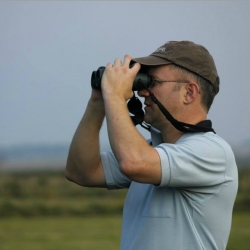Director of the Executive Office
Western Hemisphere Shorebird Reserve Network (WHSRN)
Bio:
Rob Clay is the Director of the Excecutive Office of the Western Hemisphere Shorebird Reserve Network (WHSRN), which is housed by Manomet, a Massachusetts-based nonprofit that champions better practices in conservation, business sustainability, and science education. Prior to joining Manomet, Rob worked for BirdLife International as Senior Conservation Manager in the Americas Secretariat, where he led the development of conservation programs for grassland birds, migratory birds, and globally threatened birds. Rob is the current Chair of the Waterbird Conservation Council and the Co-Councilor for Birds for the Convention on Migratory Species. Prior to working for BirdLife International, Rob worked for the lead Paraguayan conservation NGO, Guyra Paraguay, an organization he helped found in 1997. Rob received his B.A. and M.A. in Zoology and his Ph.D. in Behavioral Ecology from the University of Cambridge (U.K.). He is a native of the United Kingdom but has called Paraguay home since 1997 (except for two years spent in Ecuador). With a life-long passion for birds, his interest in neotropical birds and conservation began during an undergraduate expedition to Paraguay in 1992 and led to Ph.D. studies of manakins in Costa Rica and Panama. However, his true love is shorebirds, and he has watched them from the windswept estuaries of Patagonia, to High Andean wetlands at over 13,000 feet, Central American mangroves and mudflats, to the Boreal Forest.
Title: A drop here, a drop there: Sharing lessons throughout the hemisphere
Abstract: Great Salt Lake is one of the most important sites in the Americas for migratory shorebirds, ducks and other waterbirds, with several million birds using the lake annually. In 1991, the global significance of Great Salt Lake for shorebird conservation was recognized by its designation as a site of “Hemispheric Importance” within the Western Hemisphere Shorebird Reserve Network (WHSRN). The lake’s importance goes beyond the sheer number of birds that use its resources—it is a cornerstone of a complex ecological network of key sites for shorebirds throughout the Western Hemisphere. The loss of any one site in the network threatens the survival of the whole system.
The connectivity of Great Salt Lake was recognized early in the history of conservation efforts at the lake, when in June 1992, there was a "three-way twinning" with Laguna Mar Chiquita (Argentina) and Mono Lake (California). Both are WHSRN Sites, and share ecological similarities with Great Salt Lake, including large numbers of Wilson's Phalaropes. Further recognition of the important role of Great Salt Lake as part of a network came in 1998, when stakeholders from two additional WHSRN sites sharing species came together with Great Salt Lake to form the “Linking Communities, Wetlands and Migratory Birds Initiative” (Chaplin Lake and associated lakes in Saskatchewan, Canada, and the Marismas Nacionales complex of Nayarit, Mexico).
Unfortunately many saline lakes in the Americas (and the world) are shrinking at alarming rates, reducing shorebird habitat and economic benefits while threatening human health. Already Lago Poopó has been reduced from the second-largest lake in Bolivia to the ecological equivalent of “puddles”. Climate change is often cited as the culprit for the decline of saline lakes, and while it does represent a pervasive long-term problem for the sustainability of many saline lakes, water development in arid basins around lakes generally represents a larger and more immediate challenge.
Our talk will illustrate the linkages that connect Great Salt Lake to the rest of the hemisphere through shared migratory birds, and detail efforts to secure water and shorebird habitat at Laguna Mar Chiquita. We will also highlight a rapidly growing threat to saline lakes in the Altiplano of Argentina, Bolivia and Chile, where lithium-brine extraction has the potential to leave many watersheds desiccated. Lessons-learned from Great Salt Lake—both good and bad—could be key to the sustainability of mining operations and the future of these critical wetland resources.

